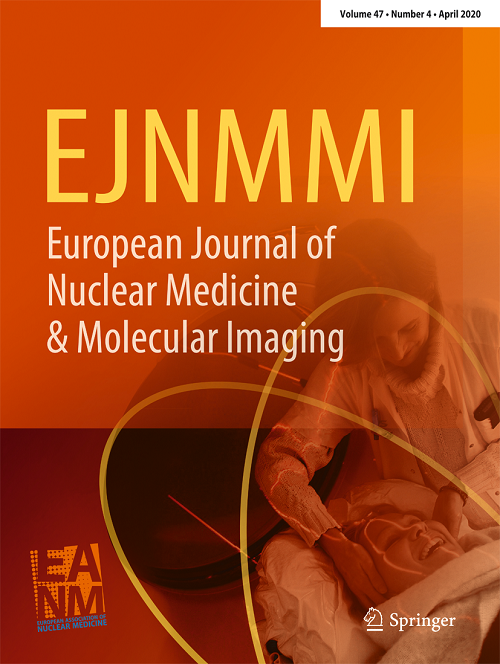Development and validation of a radiogenomics prognostic model integrating PET/CT radiomics and glucose metabolism-related gene signatures for non-small cell lung cancer.
IF 7.6
1区 医学
Q1 RADIOLOGY, NUCLEAR MEDICINE & MEDICAL IMAGING
European Journal of Nuclear Medicine and Molecular Imaging
Pub Date : 2025-05-27
DOI:10.1007/s00259-025-07354-4
引用次数: 0
Abstract
BACKGROUND Non-small cell lung cancer (NSCLC) is a highly heterogeneous malignancy characterized by altered glucose metabolism. Integration of PET/CT radiomics with glucose metabolism-related genomic signatures could provide a more comprehensive approach for prognosis and treatment guidance. METHODS Radiomics features were extracted from PET/CT images of 156 NSCLC patients from The Cancer Imaging Archive (TCIA) database, and glucose metabolism-related gene signatures were obtained from TCGA and GEO databases. We developed a multimodal radiogenomics prognostic model (RGC-score) using least absolute shrinkage and selection operator (LASSO) regression, combining PET/CT radiomics, glucose metabolism-related genes (GMR-genes). Functional enrichment analysis, immune infiltration assessment, and drug sensitivity analysis were performed to investigate the biological significance of glucose metabolism-related genes (GMR-genes). RESULTS The RGC-score model effectively stratified NSCLC patients into distinct high- and low-risk groups with significant differences in survival outcomes (P < 0.001), demonstrating excellent predictive performance (1-year AUC = 0.907, 5-year AUC = 0.968).GMR-genes are mainly involved in the process of metabolic remodeling of tumors, which is closely related to the immune microenvironment (especially CD8+ T cell infiltration) and immune checkpoint molecule expression. Additionally, significant differences in drug sensitivity were identified between glucose metabolism subtypes. CONCLUSION The RGC-score robustly predicts NSCLC prognosis and informs metabolic-immune interactions for personalized therapy. Limitations include the retrospective design and modest validation cohort size, necessitating prospective multicenter trials.结合PET/CT放射组学和葡萄糖代谢相关基因特征的非小细胞肺癌放射基因组学预后模型的开发和验证
背景:非小细胞肺癌(NSCLC)是一种以糖代谢改变为特征的高度异质性恶性肿瘤。将PET/CT放射组学与葡萄糖代谢相关的基因组特征相结合,可以为预后和治疗指导提供更全面的方法。方法从The Cancer Imaging Archive (TCIA)数据库中提取156例NSCLC患者的PET/CT图像,并从TCGA和GEO数据库中获取糖代谢相关基因特征。我们利用最小绝对收缩和选择算子(LASSO)回归,结合PET/CT放射组学、葡萄糖代谢相关基因(gmr -基因),建立了一个多模态放射基因组学预后模型(RGC-score)。通过功能富集分析、免疫浸润评估和药物敏感性分析,探讨葡萄糖代谢相关基因(GMR-genes)的生物学意义。结果rgc评分模型有效地将NSCLC患者分为高危组和低危组,生存结果差异有统计学意义(P < 0.001),具有良好的预测效果(1年AUC = 0.907, 5年AUC = 0.968)。gmr基因主要参与肿瘤的代谢重塑过程,与免疫微环境(尤其是CD8+ T细胞浸润)和免疫检查点分子表达密切相关。此外,葡萄糖代谢亚型之间的药物敏感性也存在显著差异。结论rgc -评分可有效预测非小细胞肺癌的预后,并为个性化治疗提供代谢-免疫相互作用信息。局限性包括回顾性设计和适度的验证队列大小,需要前瞻性多中心试验。
本文章由计算机程序翻译,如有差异,请以英文原文为准。
求助全文
约1分钟内获得全文
求助全文
来源期刊
CiteScore
15.60
自引率
9.90%
发文量
392
审稿时长
3 months
期刊介绍:
The European Journal of Nuclear Medicine and Molecular Imaging serves as a platform for the exchange of clinical and scientific information within nuclear medicine and related professions. It welcomes international submissions from professionals involved in the functional, metabolic, and molecular investigation of diseases. The journal's coverage spans physics, dosimetry, radiation biology, radiochemistry, and pharmacy, providing high-quality peer review by experts in the field. Known for highly cited and downloaded articles, it ensures global visibility for research work and is part of the EJNMMI journal family.

 求助内容:
求助内容: 应助结果提醒方式:
应助结果提醒方式:


